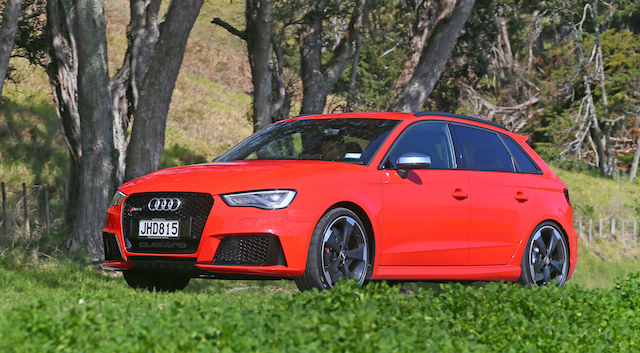
Jump on the throttle in Audi’s new RS 3 Sportback and its turbocharged 2.5-litre engine gulps enough air every minute to fill around 13,000 Rugby World Cup balls. Air is what makes internal combustion engines work. They are more an air pump than a fuel pump. Fuel is simply squirted in to ignite the air. 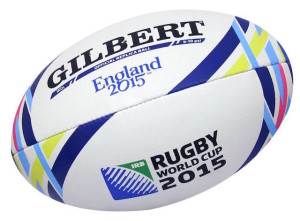 The bigger the engine the more air it pulls into the cylinders on every firing cycle. Take General Motors’ naturally aspirated 6.2-litre V8 engine. Its maximum engine speed is 6600rpm but it is most efficient at 5900rpm. At 5900rpm it’s gulping 36,580 litres of air every minute. That’s 6.2 x 5900 = 36,580. There are variables but that’s it in a theoretic nutshell. The Audi RS 3 engine is 2.480 litres and its maximim rev limit is 6800rpm. It will be more efficient at slightly lower revs but for the sake of argument let’s stick with 6800rpm. The maths works out like this: 2.480 x 6800 = 16,864 litres of air every minute … without a turbocharger. Add a turbocharger at a boost of
The bigger the engine the more air it pulls into the cylinders on every firing cycle. Take General Motors’ naturally aspirated 6.2-litre V8 engine. Its maximum engine speed is 6600rpm but it is most efficient at 5900rpm. At 5900rpm it’s gulping 36,580 litres of air every minute. That’s 6.2 x 5900 = 36,580. There are variables but that’s it in a theoretic nutshell. The Audi RS 3 engine is 2.480 litres and its maximim rev limit is 6800rpm. It will be more efficient at slightly lower revs but for the sake of argument let’s stick with 6800rpm. The maths works out like this: 2.480 x 6800 = 16,864 litres of air every minute … without a turbocharger. Add a turbocharger at a boost of
1.3 bar (for we oldies, roughly 19 extra pounds of pressure per square inch) and the Audi engine is swallowing 38,787 litres of air every minute. 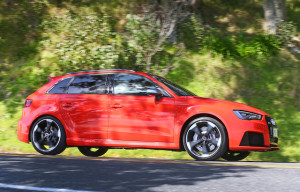 How come? Multiply 16,864 by 1.3 = 21,923 + 16,864 = 38,787. Again there are variables but that’s at 100 per cent efficiency. So the V8 and the five-cylinder are every minute ingesting roughly the same amount of air needed to fill the rugby balls, given that there is room for an estimated 3 litres of unpressured air in the cavity of the ball. The advantage the smaller turbocharged engine has over the bigger V8 is three-fold: it can provide similar power but across a wider rev range, it’s lighter, uses less fuel, and consequently emits fewer C02 emissions. This makes the emissions lawmakers happy. And it’s the way carmakers have been going for some time. The V8 isn’t dead – but these days its use is confined to expensive, high-performance cars.
How come? Multiply 16,864 by 1.3 = 21,923 + 16,864 = 38,787. Again there are variables but that’s at 100 per cent efficiency. So the V8 and the five-cylinder are every minute ingesting roughly the same amount of air needed to fill the rugby balls, given that there is room for an estimated 3 litres of unpressured air in the cavity of the ball. The advantage the smaller turbocharged engine has over the bigger V8 is three-fold: it can provide similar power but across a wider rev range, it’s lighter, uses less fuel, and consequently emits fewer C02 emissions. This makes the emissions lawmakers happy. And it’s the way carmakers have been going for some time. The V8 isn’t dead – but these days its use is confined to expensive, high-performance cars. 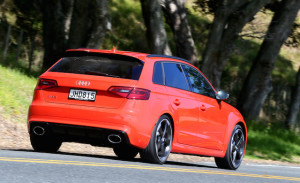 Nothing can simulate the V8 exhaust sound of a common 1-8-7-2-6-5-4-3 firing sequence. The sequence itself depends on the crankshaft, but if it’s engineered correctly in terms of time delay between each firing, the result is that of the sound
Nothing can simulate the V8 exhaust sound of a common 1-8-7-2-6-5-4-3 firing sequence. The sequence itself depends on the crankshaft, but if it’s engineered correctly in terms of time delay between each firing, the result is that of the sound
of music. The firing sequence of the five-cylinder RS 3 engine comes with a musical note all its own. It goes 1-2-4-5-3, the 3rd cylinder starting up last to help balance vibrations and so on. A new stop-start system, among other improvements like an on-demand oil pump, has helped the engine meet Euro6 compliance. The Audi five-cylinder generates 270kW between 5550-6800rpm and 465Nm between 1625rpm-5550rpm. It catapults the car from 0-100km/h in a claimed 4.3 seconds and on to an electronically governed top speed of 250km/h. The previous engine was good for a 4.6 second split. 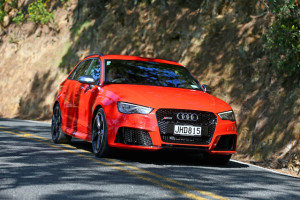 The turbo makes its presence felt at around 1700rpm, progressively surging through the rev range until upwards of 4000rpm when it adds extra oomph. But things really start to happen at 5000-5500rpm and beyond through to a redline 7000rpm. Harnessing the engine’s performance parameters is the Audi Drive Select system, with its Auto, Comfort, Individual, and Dynamic settings. The first three offer easy-peasy action, albeit with an underlying urgency. Dynamic engages everything with go-faster written on it. Upshifts in the reprogrammed seven-speed dual-clutch S Tronic gearbox are quicker. That’s when the exhaust note snaps, crackles and pops, thanks to two switchable valves downstream from the muffler that control the exhaust flow. Downshifting in Dynamic is even more of a hoot, a backfire function igniting petrol in three of the five cylinders for more exhaust violence.
The turbo makes its presence felt at around 1700rpm, progressively surging through the rev range until upwards of 4000rpm when it adds extra oomph. But things really start to happen at 5000-5500rpm and beyond through to a redline 7000rpm. Harnessing the engine’s performance parameters is the Audi Drive Select system, with its Auto, Comfort, Individual, and Dynamic settings. The first three offer easy-peasy action, albeit with an underlying urgency. Dynamic engages everything with go-faster written on it. Upshifts in the reprogrammed seven-speed dual-clutch S Tronic gearbox are quicker. That’s when the exhaust note snaps, crackles and pops, thanks to two switchable valves downstream from the muffler that control the exhaust flow. Downshifting in Dynamic is even more of a hoot, a backfire function igniting petrol in three of the five cylinders for more exhaust violence. 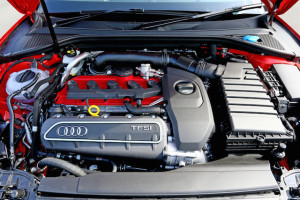 The RS 3 is the entry point to the RS club. New Zealanders bought 80 RS 3s between 2011 and 2013, when production of the previous model stopped. Audi reckons it will shift between 40 and 50 newbies before the end of 2015, each one starting in price at $99,990. “We pull people from lots of other marques,” said Audi NZ general manager Dean Sheed. The RS 3 is easy to recognise. There’s the RS badging, gloss black grille with ‘quattro’ lettering, 19-inch wheels, flared arches for the wider track and tyres, standard LED headlights … and an exhaust pipe at each rear corner. It’s underpinned by the Volkswagen Group’s flexible MQB platform, the result of which is a weight saving of 55kg over the previous model. There are gains in structural rigidity and interior room too. Step inside and it’s almost understated. There are no unnecessary shiny bits, no over-dressing. The RS 3-embossed driver’s seat immediately feels like an old pair of slippers. Take a minute to look around and the go-faster bits present themselves. The turbo boost gauge is inset into the rev counter; the lap timer into the drive computer.
The RS 3 is the entry point to the RS club. New Zealanders bought 80 RS 3s between 2011 and 2013, when production of the previous model stopped. Audi reckons it will shift between 40 and 50 newbies before the end of 2015, each one starting in price at $99,990. “We pull people from lots of other marques,” said Audi NZ general manager Dean Sheed. The RS 3 is easy to recognise. There’s the RS badging, gloss black grille with ‘quattro’ lettering, 19-inch wheels, flared arches for the wider track and tyres, standard LED headlights … and an exhaust pipe at each rear corner. It’s underpinned by the Volkswagen Group’s flexible MQB platform, the result of which is a weight saving of 55kg over the previous model. There are gains in structural rigidity and interior room too. Step inside and it’s almost understated. There are no unnecessary shiny bits, no over-dressing. The RS 3-embossed driver’s seat immediately feels like an old pair of slippers. Take a minute to look around and the go-faster bits present themselves. The turbo boost gauge is inset into the rev counter; the lap timer into the drive computer. 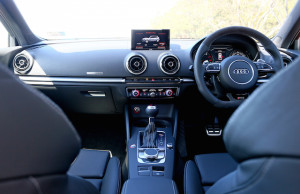 The RS 3 rides 25mm lower and uses more high-strength components in its suspension set-up (MacPherson strut front/multi-link rear) than the standard A3 five-door. Standard alloys are 19-inches. The quattro all-wheel-drive system’s multi-plate clutch has been reworked to send 100 per cent of torque to the rear wheels, if needed, and is mounted on the rear axle to improve weight distribution. On the open road in Auto or Comfort, the standard magnetic ride adaptive dampers help to smooth progress. The system has been around for some time now. It consists of minute metal particles suspended within the fluid in each suspension damper. An electric current charges the particles to produce a magnetic field. This changes the viscosity of the fluid, producing a continuously variable damping force that adapts to changing road surfaces without the delays of mechanical systems. In Dynamic mode, on a wet Taupo race track, with the engine howling as the paddle-shift changes go up and down, the quattro system distributing torque front and rear and working with torque vectoring to brake the inside wheels to aid cornering, the magnetic damping adjusting from a smooth surface one second to a ribble strip the next, much fun is to be had.
The RS 3 rides 25mm lower and uses more high-strength components in its suspension set-up (MacPherson strut front/multi-link rear) than the standard A3 five-door. Standard alloys are 19-inches. The quattro all-wheel-drive system’s multi-plate clutch has been reworked to send 100 per cent of torque to the rear wheels, if needed, and is mounted on the rear axle to improve weight distribution. On the open road in Auto or Comfort, the standard magnetic ride adaptive dampers help to smooth progress. The system has been around for some time now. It consists of minute metal particles suspended within the fluid in each suspension damper. An electric current charges the particles to produce a magnetic field. This changes the viscosity of the fluid, producing a continuously variable damping force that adapts to changing road surfaces without the delays of mechanical systems. In Dynamic mode, on a wet Taupo race track, with the engine howling as the paddle-shift changes go up and down, the quattro system distributing torque front and rear and working with torque vectoring to brake the inside wheels to aid cornering, the magnetic damping adjusting from a smooth surface one second to a ribble strip the next, much fun is to be had.
- Three things in passing about the new five-door RS 3 Sportback: (1) it arrives in New Zealand on the 20th birthday of its A3 donor car and (2) it’s the 35th birthday of the famed all-wheel-drive quattro system that anchors its drivetrain. More importantly, (3) the per-capita sale in New Zealand of RS-badged Audis is the highest in the world. The penetration here is 9.7 per cent. Switzerland is next with 5.0 per cent, followed by Australia (2.7), Japan (2.2), Germany (2.0), South Africa (1.7), Great Britain (1.6), Canada (1.5), Brazil (1.0), France, USA, Russia (O.9), Ital (0.8), Belgium (0.7). The global penetration of RS badges is 0.8 per cent.
